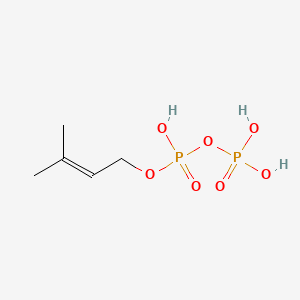| MeSH term | MeSH ID | Detail |
|---|---|---|
| Melanoma | D008545 | 69 associated lipids |
Dimethylallyl pyrophosphate
Dimethylallyl pyrophosphate is a lipid of Prenol Lipids (PR) class. Dimethylallyl pyrophosphate is associated with abnormalities such as Consumption-archaic term for TB and Wiskott-Aldrich Syndrome. The involved functions are known as Anabolism, Biochemical Pathway, Oxidation, Process and Chelating Activity [MoA]. Dimethylallyl pyrophosphate often locates in Chloroplasts, Plastids, chloroplast stroma, Cytosol and Cell membrane. The associated genes with Dimethylallyl pyrophosphate are IRF6 wt Allele and ADRBK1 gene. The related lipids are Sterols.
Cross Reference
Introduction
To understand associated biological information of Dimethylallyl pyrophosphate, we collected biological information of abnormalities, associated pathways, cellular/molecular locations, biological functions, related genes/proteins, lipids and common seen animal/experimental models with organized paragraphs from literatures.
What diseases are associated with Dimethylallyl pyrophosphate?
Dimethylallyl pyrophosphate is suspected in and other diseases in descending order of the highest number of associated sentences.
Related references are mostly published in these journals:
| Disease | Cross reference | Weighted score | Related literature |
|---|
Possible diseases from mapped MeSH terms on references
We collected disease MeSH terms mapped to the references associated with Dimethylallyl pyrophosphate
PubChem Associated disorders and diseases
What pathways are associated with Dimethylallyl pyrophosphate
Lipid pathways are not clear in current pathway databases. We organized associated pathways with Dimethylallyl pyrophosphate through full-text articles, including metabolic pathways or pathways of biological mechanisms.
Related references are published most in these journals:
| Pathway name | Related literatures |
|---|
PubChem Biomolecular Interactions and Pathways
Link to PubChem Biomolecular Interactions and PathwaysWhat cellular locations are associated with Dimethylallyl pyrophosphate?
Visualization in cellular structure
Associated locations are in red color. Not associated locations are in black.
Related references are published most in these journals:
| Location | Cross reference | Weighted score | Related literatures |
|---|
What functions are associated with Dimethylallyl pyrophosphate?
Related references are published most in these journals:
| Function | Cross reference | Weighted score | Related literatures |
|---|
What lipids are associated with Dimethylallyl pyrophosphate?
Related references are published most in these journals:
| Lipid concept | Cross reference | Weighted score | Related literatures |
|---|
What genes are associated with Dimethylallyl pyrophosphate?
Related references are published most in these journals:
| Gene | Cross reference | Weighted score | Related literatures |
|---|
What common seen animal models are associated with Dimethylallyl pyrophosphate?
There are no associated biomedical information in the current reference collection.
NCBI Entrez Crosslinks
All references with Dimethylallyl pyrophosphate
Download all related citations| Authors | Title | Published | Journal | PubMed Link |
|---|---|---|---|---|
| Fu X et al. | Plastid structure and carotenogenic gene expression in red- and white-fleshed loquat (Eriobotrya japonica) fruits. | 2012 | J. Exp. Bot. | pmid:21994170 |
| Qian Q et al. | Mechanistic studies on CymD: a tryptophan reverse N-prenyltransferase. | 2012 | Biochemistry | pmid:22935004 |
| Behr M et al. | Remodeling of cytokinin metabolism at infection sites of Colletotrichum graminicola on maize leaves. | 2012 | Mol. Plant Microbe Interact. | pmid:22746825 |
| Testa CA and Johnson LJ | A whole-cell phenotypic screening platform for identifying methylerythritol phosphate pathway-selective inhibitors as novel antibacterial agents. | 2012 | Antimicrob. Agents Chemother. | pmid:22777049 |
| Lu XM et al. | Map-based cloning of zb7 encoding an IPP and DMAPP synthase in the MEP pathway of maize. | 2012 | Mol Plant | pmid:22498772 |
| Song AA et al. | Functional expression of an orchid fragrance gene in Lactococcus lactis. | 2012 | Int J Mol Sci | pmid:22408409 |
| Kuzuyama T and Seto H | Two distinct pathways for essential metabolic precursors for isoprenoid biosynthesis. | 2012 | Proc. Jpn. Acad., Ser. B, Phys. Biol. Sci. | pmid:22450534 |
| Trowbridge AM et al. | Contribution of various carbon sources toward isoprene biosynthesis in poplar leaves mediated by altered atmospheric CO2 concentrations. | 2012 | PLoS ONE | pmid:22384238 |
| Yang ZB et al. | Physiological and molecular analysis of the interaction between aluminium toxicity and drought stress in common bean (Phaseolus vulgaris). | 2012 | J. Exp. Bot. | pmid:22371077 |
| Türsen U | Pathophysiology of the Behçet's Disease. | 2012 | Patholog Res Int | pmid:21977335 |
| Fischer MJ et al. | Identification of a lysine residue important for the catalytic activity of yeast farnesyl diphosphate synthase. | 2011 | Protein J. | pmid:21643844 |
| Heaps NA and Poulter CD | Synthesis and evaluation of chlorinated substrate analogues for farnesyl diphosphate synthase. | 2011 | J. Org. Chem. | pmid:21344952 |
| Thabet I et al. | The subcellular localization of periwinkle farnesyl diphosphate synthase provides insight into the role of peroxisome in isoprenoid biosynthesis. | 2011 | J. Plant Physiol. | pmid:21872968 |
| Nes WD | Biosynthesis of cholesterol and other sterols. | 2011 | Chem. Rev. | pmid:21902244 |
| Heaps NA and Poulter CD | Type-2 isopentenyl diphosphate isomerase: evidence for a stepwise mechanism. | 2011 | J. Am. Chem. Soc. | pmid:22047048 |
| Umeda T et al. | Molecular basis of fosmidomycin's action on the human malaria parasite Plasmodium falciparum. | 2011 | Sci Rep | pmid:22355528 |
| Wen W and Yu R | Artemisinin biosynthesis and its regulatory enzymes: Progress and perspective. | 2011 | Pharmacogn Rev | pmid:22279377 |
| Lu J et al. | Human ovarian tumor cells escape γδ T cell recognition partly by down regulating surface expression of MICA and limiting cell cycle related molecules. | 2011 | PLoS ONE | pmid:21935360 |
| Nair SC and Striepen B | What do human parasites do with a chloroplast anyway? | 2011 | PLoS Biol. | pmid:21912515 |
| Yeh E and DeRisi JL | Chemical rescue of malaria parasites lacking an apicoplast defines organelle function in blood-stage Plasmodium falciparum. | 2011 | PLoS Biol. | pmid:21912516 |
